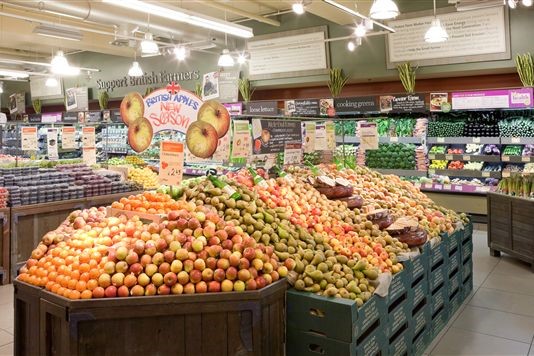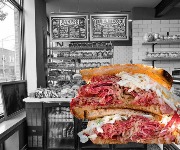The ultimate food experience

Whole Foods has landed smack bang in the middle of the UK. Kirsty Page finds out what all the fuss is about.
Whole Foods started out as one small store in Austin, Texas, in 1980. Fast Forward three decades and there are stores in 39 US states, and four in the UK. All of them, so far, in London – but there’s one opening in Glasgow next year, and potentially, there will be further expansion across Britain soon.
This is good news for lovefood.com readers. Whole Foods, which positions itself as ‘the ultimate food experience’, is exactly the type of shop that we would like to see more of in the UK.
Never been to one? lovefood.com visited the flagship store in Kensington (there are also branches in Camden, Soho, Clapham Junction and Stoke Newington) to find out exactly what this shop has got over its rivals.
What’s different about it?
Whole Foods sells food. Lots of it. So, in theory, you could lump it in the supermarket category. But there is something so un-supermarkety about it. It’s not just aisle after aisle of shrink wrapped food but somewhere you can really see what you’re getting, and more importantly, enjoy shopping.
The main driving force behind the shop is their commitment to providing natural and organic products. Whole Foods firmly believe that food in its purest state, free from any additives, sweeteners, colourings and preservatives, is the best tasting and most nutritious there is.
But what really makes this a grocery store which stand out from the rest is, in our opinion, the care Whole Food takes to provide customers with transparency about the ethics of the food they have on sale. For example, there’s a ‘Quality Standard team’ which carefully checks new products it is considering offering for sale against an extensive list of unacceptable ingredients, and an animal welfare standards scale that is used to label its meat and fish. All fresh produce on display has a label showing the origin of the food, where in the world it was farmed and who by.
“We have dedicated buying teams for each department, scouring the UK and Europe for artisan producers,” explains Whole Foods spokesperson Ben Woodgate. “We are constantly striving to connect our customers to the people who produce our goods.”
Of course, this is not new. The big supermarkets also take approach , with their ‘farmer Giles’ sausages and ‘Loch made-up-placename’ salmon. But Whole Foods don’t just stick pictures on labels and give their produce a fancy marketing spin – they literally seem to be trying to create local farm shops in inner-city locations.
For example, when we visited Whole Foods, the produce section looked like a village show, displaying the best of the best. Crates were creaking under the weight of plump, juicy tomatoes with vibrant, fresh greens lining the shelves nearby. They were making the most of the short British asparagus season with bundles of fresh spears on display that looked far superior to their Peruvian cousins and the meat counter was selling only selling meat from animals reared on farms in the United Kingdom. This truly is seasonal, local, sustainable produce.
But is it fresh?
Fresh is best
In a word: yes. Much of the local produce sold in Whole Foods has travelled less than seven hours from farm to store.
For example, there’s freshly baked bread from the bakery and succulent sausages from the meat counter in every conceivable flavour, made from scratch every day. You can even get your coffee grounded in front of you!
How does the store manage to keep its produce so fresh? Doesn’t this mean a lot of food is wasted?
Ah, yes, they’ve thought of that. Anything that is nearing its sell by date simply gets used up in store cafes which provide healthy hot and cold dishes to eat in or take away.
What’s more, the store is constantly trying to help its customers understand the value of eating natural, fresh, whole foods using its Health Starts Here programme. Each store has its own nutritionist should you have any questions and there are leaflets and recipe cards dotted around the store. Many of their foods are labelled using the Aggregate Nutrient Density Index (ANDI) scoring system, helping you to make healthy choices.
Variety
So far, so good. But can Whole Foods offer the depth and breadth of products that a normal supermarket can?
Let’s take milk as an example. As well as what you might usually find in the chiller, in Whole Foods there is soya, buffalo, almond and quinoa milk to name just a few – perfect for those who suffer from allergies and food intolerances, as well as fussy city-dwelling foodies and yummy mummies.
What’s more, you can bulk buy. Whether it’s rice, flour, beans or cereals you’re after, you can stock up and buy exactly how much you want without having to buy endless packets of the same thing.
Pop in!
So, if you live in London or pay a visit every now and again, it’s well worth popping into Whole Foods for a full-on foodie experience.
And try the Kensington Sizzler sausage – it is Ben’s personal recommendation, labelling it “the ultimate barbeque banger!”
Well there you go, high praise indeed....
What do you think?
Have you ever been to a Whole Foods store? Do you think its reputation for good quality produce is well-deserved? Are there other shops in your local area that you think are just as good? Let us know using the comments box below!
Also worth your attention:
Most Recent
Comments
Be the first to comment
Do you want to comment on this article? You need to be signed in for this feature








